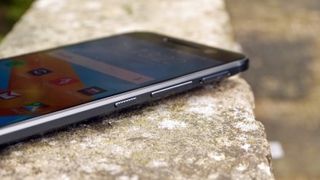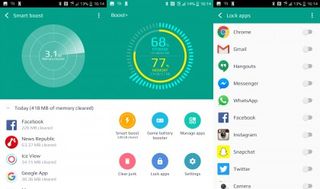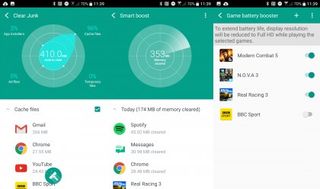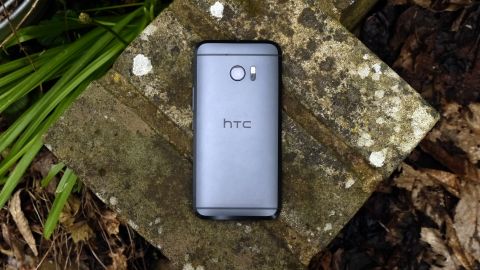Why you can trust TechRadar
- Really quick under the finger
- High end specs don't add a lot bar video processing
- Boost+ helps maintain performance
- Sense upgrades make the UI really slick
- New sticker icons add new level of personalistion
The power of the HTC 10 is up there with the best of them, taking some of the best components available at launch and making them into something that's actually usable.
I mean, come on... what can we really do with 4GB of RAM on a smartphone, or a chipset that's running two 2.15 GHz Kryo and two 1.6 GHz Kryo over four cores, as it does in the Snapdragon 820?
Sure, it can crank up and down where needed, but what needs to be done is making that power run in an efficient and more useable way.
That's where I was impressed once again with HTC's stance: it says it tuned the phone to be more responsive to the touch compared to the rest of the competition.
According to Darren Sng, HTC's head of global product marketing, this means that the 10 is faster than the iPhone in its speed of finger tap recognition, which is unheard of from the Android world.

That's the kind of thing that some brands only dream about, as the base Google Android platform for touch response has to be geared for multiple models rather than just one, so it's difficult to tune your own phone to be as speedy as possible.
Running on top of Android 7 Nougat (after an update from Android 6.0.1) software, the HTC 10 is certainly rapid under the finger, and hasn't shown much in the way of slowdown since I started using it.
I wouldn't say the amount of snap it has is instantly noticeable, but then again, that could be because I came from using the iPhone SE rather than just a bog-standard Android handset.
It certainly didn't irk though, I'll confirm that, and playing around with the opening speed saw nary a flicker when tapping apps - some needed to be opened once to pick up speed, but generally it was perfect nearly every time.
One oddity is in the gallery - trying to pinch and zoom into pictures isn't accurate, as it seems the phone is looking to register a swipe for the next photo, and gets momentarily confused when two fingers are registered.
The HTC 10 also went through our speed test along with five of the other best phones you can buy right now, including the iPhone 6S, LG G5, Samsung Galaxy S7, Huawei P9 and Sony Xperia Z5.
This test involves booting up the phone, running through a series of 10 apps and then repeating the apps for another lap. Whichever phone finishes first is the winner, and sadly that wasn't the HTC.
The HTC 10 came fifth when we included boot up times, but if you take those times out it came last, being beaten by the Sony Xperia Z5.
This is only a very particular type of test though and is by no means scientific. The GeekBench 3 numbers back up the phone's performance, with one of the highest results seen from a smartphone right now.
That's 4962, and while that's nowhere near the dizzying Galaxy S7 with its 6542 performance, it's significantly faster than the 3803 achieved by 2015's One M9.
Then again, there was very little wrong with the speed of the M9, so to read too much into such numbers is a little pointless. I certainly couldn't find much in the way of slowdown in the previous model, even after extended use, so there's not much to worry about here.
Boost+
Those worried about the performance of their smartphone should never look much further than the apps that are clogging it up - and to that end, HTC's added Boost+ to the mix on the 10.
That means it's the latest brand to have a 'clean up center' on its smartphone, following hot in the footsteps of Samsung and LG, but not only is Boost+ actually rather good but it's also available on the Play Store to give other Android users the chance to use it.
The premise is simple: you can delete pointless files cluttering up the phone, tune down applications that are pushing things too hard, lower the gaming performance of your least favorite titles to improve battery and, for some reason, lock apps, all from the same place.

It's a neat idea and one that works pretty well - although it takes an age to scan through the phone and decide what does and doesn't need to be ejected from the handset. Given I just pointed out that the HTC 10 has too much power, that feels a little hypocritical, but it's one of the few places I noticed it.

However, I want to see more from an app like this. We should be getting hints at the right time from it, telling us when it's intelligently worked out that we could improve performance in certain ways - but instead it's something you go into when you remember to, and get a little performance bump.
Interface
Right - this is one of the 'big' changes from HTC on the 10 compared to flagship phones of the past. With the One A9, HTC worked with Google to be one of the first brands out with Marshmallow on a non-Nexus device, and in doing so took the chance to work with the search giant to make its icons and overall UI much sleeker and like stock Android.
The move has been continued on the HTC 10, with the removal of duplicate apps where Google options are more powerful or just work better. The idea there is that the user won't have to wade through a load of bloatware to get to the apps they want, and HTC can sort out the updates for the phone more quickly, rather than having to optimise each app for every new version of Android.
A few issues there though: firstly, some apps like Mail still remain, which to my eye aren't any better than Google's own Mail app. Perhaps they are a little more powerful, but when you have to enter your POP settings just to set up a Gmail account on the app, it's already a barrier too far in my mind.
Secondly, HTC still has apps like Facebook and Instagram pre-installed on the phone when you turn it on. Yes, you can uninstall them, like a lot of apps on there, but that's still not going to be wanted by every user.
The situation is much worse in the US, where the brand is still forced to put up with carriers sticking their own apps on the phone at launch, so here's hoping that this practice is phased out soon.

I know a lot of people will be happy about the new streamlined interface, but I can't say it wows me that much. It's sleeker and more of a blank canvas sure, but does it really add anything that makes this phone obviously HTC?
I would have pointed to BlinkFeed as an option here, but that's now become rather messy. As News Republic now handles more than just your top headlines to parse through - with social networking taken under its wing - the screen located to the left of your home display is full of loads of words and pictures packed in together, where before it gave a nice mix of news, Facebook and Twitter updates and snaps from your gallery.
Other than that, this is a very sleek and modern interface that mimics a lot of what you'll see on Nexus phones - with one key difference on the HTC 10: Freestyle layouts.
These are a new idea from HTC to make your home screens more like a desktop from a computer - allowing you to lay out your icons as stickers wherever you want on the screen.
You can even drop the names from your apps to make the picture look even cleaner, but I can totally see myself forgetting what I meant that cat or rocket ship to be and having to keep opening everything to find out which is which.
It's a nice touch, and one that will resonate well with the youth market where customisation is king - although it doesn't add a huge amount of extra functionality, it shows that even with a collaboration with Google HTC still has creativity beating at its centre.
The basics of Sense are still all there though, despite the machining the HTC 10 has undergone to make everything feel a bit more Google-y. The keyboard is still very much the same as ever from the brand, for instance - although I'm not sure that's a good thing as it's not as good as some of the aftermarket options any more.
Overall, Sense is just cleaner, as shown by the way it's no longer given a number, rather just 'Android with HTC Sense' to show the differentiation between this phone and a stock Nexus device.
There's still enough of HTC's DNA about the interface to make it feel a cut above the standard Android experience, and the tuning done to improve speed really does work - there's a zip about this handset that anyone coming from a phone circa 2014 will hugely appreciate.

Gareth has been part of the consumer technology world in a career spanning three decades. He started life as a staff writer on the fledgling TechRadar, and has grown with the site (primarily as phones, tablets and wearables editor) until becoming Global Editor in Chief in 2018. Gareth has written over 4,000 articles for TechRadar, has contributed expert insight to a number of other publications, chaired panels on zeitgeist technologies, presented at the Gadget Show Live as well as representing the brand on TV and radio for multiple channels including Sky, BBC, ITV and Al-Jazeera. Passionate about fitness, he can bore anyone rigid about stress management, sleep tracking, heart rate variance as well as bemoaning something about the latest iPhone, Galaxy or OLED TV.


